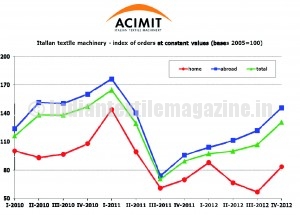
Orders for Italian textile machinery are on the rise for both the domestic and foreign markets. What is needed now is to boost investments in capital goods and work together in foreign markets.
Based on an industry study conducted by ACIMIT, the Association of Italian Textile Machinery Manufacturers, during the fourth quarter of 2012, the orders index for textile machinery rose by 22 per cent compared to the previous quarter, for an absolute value of 130.4 points. Even more significant was the increase with respect to the same period of the previous year (+46 per cent).
Overall orders also benefitted from a positive trend on the domestic market, for which a 47 per cent increase was actually recorded compared to the three previous months. The value stood at 83.5 points. Growth on foreign markets was slightly more contained at +20 per cent.
“The fourth quarter data are comforting”, comments ACIMIT President Sandro Salmoiraghi, “and are a good omen for 2013, but we still need to consider that overall the year 2012 closed with a decrease compared to 2011.”
In fact, on an annual basis the orders index fell by four per cent, for a value of 108.6 points. Abroad, the comparison on the previous year recorded a slight drop (- one per cent), while the domestic market represented a 21 per cent decrease.

“In Italy, we’re registering the effects of an overall climate of scant confidence in the future, a fact that is common to businesses and families alike,” observes Salmoiraghi. “We need reforms capable of promoting growth, such as those recently proposed by Confindustria aimed at cutting business costs, starting from the cost of labour, while boosting investments in capital goods. These issues must be prioritized in the industrial policies enacted by the next government.”
He concludes with the statement: “Abroad, where our manufacturers realize 80% of their turnover, we need to work together in a structured manner. This is why we ask that the Italian Trade Promotion Agency (ICE) be provided with greater resources for promoting Made in Italy products in foreign markets, avoiding that public funds for internationalization are wasted in many unstructured projects.”